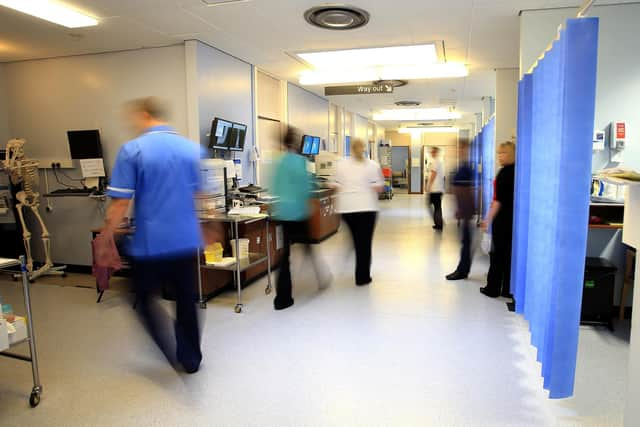NHS Scotland crisis: The year ahead in Scotland's NHS, A&E departments and GP surgeries
The consequences of the coronavirus pandemic still weigh heavy on Scotland’s healthcare system, with parts of NHS Scotland grinding to a halt despite the best efforts of tenacious and talented staff.
But can we expect an improvement in 2024?
Winter pressures


The pressures left by Covid-19’s legacy have never been more obvious than during the past few winters, when NHS Scotland’s performance has dropped to dangerous levels.
Advertisement
Hide AdAdvertisement
Hide AdDr Lailah Peel, an accident-and-emergency (A&E) medic working in the Central Belt, recently told The Scotsman the conditions in NHS Scotland’s emergency departments had left staff “wondering how much more they can take” – with the only “good days” coming when doctors feel they “are not running around thinking someone is going to die”.
Patients are already being left waiting outside in ambulances, which doesn’t count towards Scottish Government A&E waiting times figures. Sick people are being dumped in corridors “with no real nursing or medical care” while they wait to be seen.
Dr Peel said 24-hour waits are “no longer unusual” in Scotland’s A&E departments – a claim backed up by the recent revelation that 4,000 Scots waited more than 24 hours in A&E in the first six months of last year – with some managers even admitting “they hope people just don’t turn up”.
During last winter’s NHS crisis, the Royal College of Emergency Medicine (RCEM) in Scotland warned there was an excess mortality of 50 deaths in Scotland every week, due to the pressure on emergency departments.
Increasingly long waiting times lead to poorer outcomes for patients, causing needless deaths which would otherwise have been prevented.
Last winter – “the worst winter ever”, according to the-then first minister Nicola Sturgeon – Scotland’s hospitals reached 95 per cent capacity, waiting times for A&E soared and ambulances queued up outside. The severity of the situation led Ms Sturgeon to host weekly, televised press conferences.
In the autumn, the RCEM warned recent A&E figures showed Scotland was “heading towards the colder weather with a poorer baseline than a comparable period in 2022”. This January and February could therefore see a period of intense turmoil and pressure in Scotland’s hospitals, particularly in A&E and emergency departments.
Recruitment and retention
The number of staff leaving the profession, and the struggle to attract new workers, is one of the driving factors adding pressure on the NHS.
Advertisement
Hide AdAdvertisement
Hide AdElderly and vulnerable patients often can’t be discharged from hospital without an adequate care plan. But with no availability of care home and community care placements due to staffing issues, these patients, who are otherwise fine to leave, end up blocking beds.
With no beds available, patients presenting at emergency departments have nowhere to go and face incredible waits in A&E before being treated.
Without a concentrated effort to attract new staff into the care sector, it’s unlikely hospitals will find much relief.
The issue has been exacerbated by Brexit, due to the sector’s high reliance on foreign workers, and could be further exacerbated by the UK Government’s plans to reduce immigration.
In A&E departments, the pressure has been unbearable for some staff, who have already lived through some of the darkest days in the NHS’s history, during the coronavirus pandemic.
Young, homegrown healthcare professionals are increasingly being lured away from the UK by better working conditions in Commonwealth countries such as Australia, New Zealand and Canada, while older staff members are reducing their hours or taking early retirement.
The Scottish Government’s failure to retain and recruit GPs has led to doctors implementing “never-before-seen” emergency measures in surgeries, according to the Royal College of General Practitioners (RCGP) Scotland.
The joint chair of RCGP Scotland, Dr Chris Williams, has called on the Scottish Government to give “purposeful and simultaneous attention” to the “profound issues of workload, workforce, and welfare within general practice”.
Advertisement
Hide AdAdvertisement
Hide AdDespite promises from the Scottish Government to recruit more GPs, an annual survey from NHS Education for Scotland has found both the GP headcount and whole-time equivalent, which totals part-time GP hours and counts them as an equivalent to a full-time GP, have decreased.
The GP headcount, excluding specialist trainees, fell from 4,514 in 2022 to 4,474 this year. GP whole-time equivalents decreased from 3,493.9 in 2022 to 3,478.4 in 2023.
Unless this trend is reversed, Scotland could see more GPs leaving the health service in 2024, and fewer students training to replace them. This could lead to more GP surgeries closing, as happened in April when Inverurie Medical Practice collapsed.
Despite a dedicated team of partners, a commitment to training and retaining new doctors and a patient list in excess of 25,000 people, one of the largest GP surgeries in Scotland felt it had to hand its contract back to the local authority.
If a “too-big-to-fail” practice like Inverurie can fall, then smaller, local GP surgeries are likely teetering on the edge as well, and there could be more closures over the coming year.
Simply put, without the Scottish Government getting to grips with the recruitment and retention crisis across nursing, clinical medicine, GP surgeries and care homes, then the coming year in health is set to be very similar to the preceding one – with patients unable to see their local GP, hospitals running at near-full capacity and A&Es malfunctioning dangerously.
Excess deaths, already high due to enormous waiting lists and problems with primary care, will continue, and more Scots will be pushed towards private healthcare, potentially exacerbating the cost-of-living crisis.
Comments
Want to join the conversation? Please or to comment on this article.